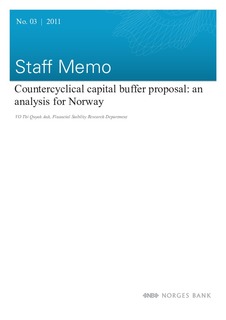| dc.contributor.author | Vo, Thi Quynh Anh | |
| dc.date.accessioned | 2018-08-02T13:30:20Z | |
| dc.date.available | 2018-08-02T13:30:20Z | |
| dc.date.issued | 2011 | |
| dc.identifier.isbn | 978-82-7553-595-3 | |
| dc.identifier.issn | 1504-2596 | |
| dc.identifier.uri | http://hdl.handle.net/11250/2507333 | |
| dc.description.abstract | This paper evaluates the ability of some macro variables, namely GDP growth, credit growth, credit to GDP ratio and property prices in guiding the accumulation of a capital buffer above the minimum during the credit expansion episode in Norway. We use two performance benchmarks. First, we evaluate their performance based on their skill in signalling a financial crisis. Second, we compare their performance on the basis of their correlation with a measure of the banking system s vulnerability. The main conclusion we derive from the analysis is that the credit to GDP ratio has the best performance. Moreover, data limitations seriously affect the usefulness of the Norwegian residential property price as banking crisis indicator. | nb_NO |
| dc.language.iso | eng | nb_NO |
| dc.publisher | Norges Bank | nb_NO |
| dc.relation.ispartofseries | Staff Memo;3/2011 | |
| dc.rights | Attribution-NonCommercial-NoDerivatives 4.0 Internasjonal | * |
| dc.rights.uri | http://creativecommons.org/licenses/by-nc-nd/4.0/deed.no | * |
| dc.title | Countercyclical Capital Buffer Proposal : An Analysis for Norway | nb_NO |
| dc.type | Working paper | nb_NO |
| dc.subject.nsi | VDP::Samfunnsvitenskap: 200::Økonomi: 210 | nb_NO |
| dc.source.pagenumber | 20 | nb_NO |

